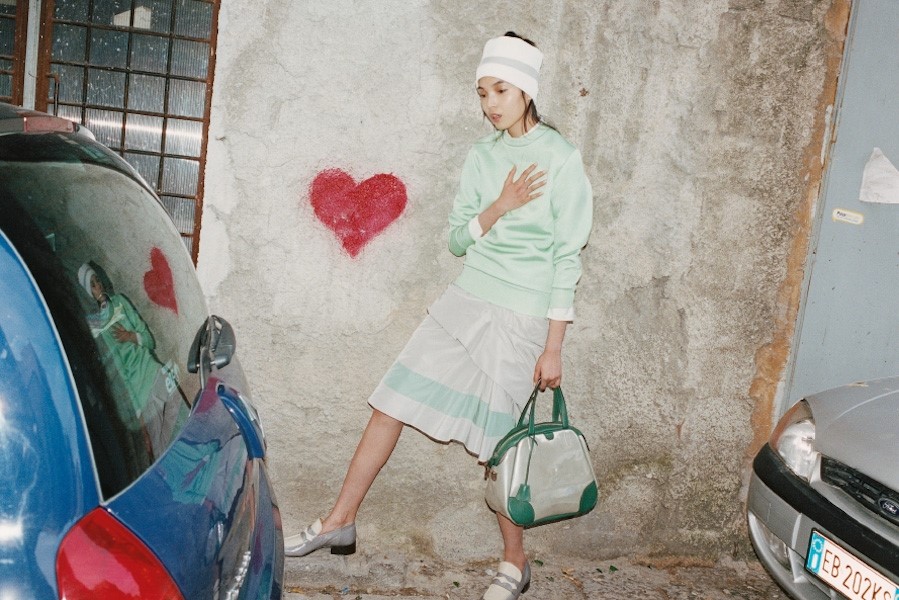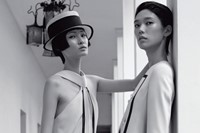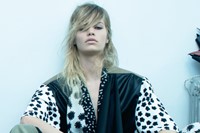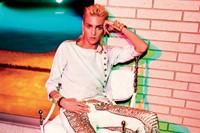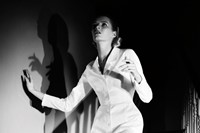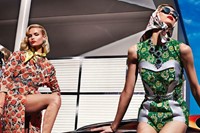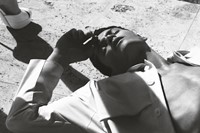Following our examination of the body language of designers at the end of their A/W12 shows, this week we turn our attention to the S/S12 campaigns including men's and women's Marc Jacobs, Jil Sander and Louis Vuitton...
Following our examination of the body language of designers at the end of their A/W12 shows, this week we turn our attention to the S/S12 campaigns. Research has shown that as much as 70% of communication comes from body language. This leaves a wealth of opportunity for fashion designers to convey their desired message for the season through advertising campaigns...
Marc Jacobs has taken a child-like approach to advertising his women’s S/S12 collection. This is indicated by the heart shaped picture on the wall, the purity of the clothing colours, and the innocent look on the model's face. Jacobs is using an image of innocence and purity to attract consumers.
"Marc Jacobs has taken a child-like approach to advertising indicated by the heart shaped picture on the wall, the purity of the clothing colours, and the innocent look on the models face"
The use of two models, who are standing relatively close, portrays a sense of intimacy in the Emporio Armani women's campaign. With one model leaning towards the other, the advert has a personal element about it. The calm composure of the models further indicates comfort with intimacy. It is likely that Armani wants to be perceived as removing boundaries and bringing people closer together.
In the Balanciaga campaign, model Kirsten Liljegren looks relaxed and cool – leant againt the wall, legs bent, hair covering her eyes. Inspired by personal photos in Patti Smith's memoir, Just Kids, taken at the legendary Hotel Chelsea.
The pose in the Balmain campaign is also indicative of a relaxed attitude, but powerfully portrays a very cool image, hence the hand on the hip and the other as a rest for Anja Rubik's head. Looking directly at the camera, Balmain wants to convey the sense of confidence that can come from wearing the collection. The combing back of the model’s hair also shows sleekness in design.
The Jil Sander women's campaign makes reference to the films of Alfred Hitchcock; Grace Kelly, one of Hitchcock's leading ladies was one of the inspirations of the collection. The lack of colour in the shot suggests that this clothing range speaks for itself. Daria Strokous and her surroundings are insignificant in comparison to the clothes. At the same time, the model's upward gaze and open posture suggests a sense of urgency; the model is trying to get somewhere fast and yet her clothes portray a sense of composure in the rush. These designs are for busy women who still want to take pride in their appearance.
In the Prada women's campaign, the sideways slanting of the head and the pouting lips demonstrated by both models indicates playfulness and flirting. There is also a clear message of femininity being portrayed. These designs are made for strong, powerful women who are proud of their femininity and want to flaunt it in an empowering way.
"Clenched fists usually convey aggression, but when combined with the loose body language – shoulders down, head forward, lips pouting – the Prada men's campaign featuring Michael Pitt can be seen as light-hearted and fun"
In the men's campaign, Emporio Armani wants to portray a laid-back image. The opening of the shirt and the baring of flesh would suggest to the consumer that Armani’s designs are comfortable and light. The message is that when wearing Armani, men will not feel constricted by the garments.
In the Dior men's campaign, the pose demonstrates a sense of superiority and fearlessness, as indicated by the head held high with the chin pointing outwards. Holding the chin up also indicates pride, defiance, and confidence. By exposing the neck, an image of strength and resilience is portrayed. The chosen pose within this advertising campaign makes the model stand taller and bigger, demonstrating his presence. The collection is for men who want to be seen, who want their presence to be known, and who emit confidence and style.
Louis Vuitton has taken a more casual, "man next door" approach to advertising for its men's campaign. By partly covering his mouth, Werner Schreyer portrays some bashfulness and restraint. Unlike, the Dior clothing range, modesty and reserve is the key message within this advert. The Vuitton clothing range is for the casual man, who wants to look good but doesn’t necessarily want to raise eyebrows.
As with the women’s S/S12 advertising campaign, Marc Jacobs has again taken a fun, child-like approach to advertising his men’s collection. The pram, which is suggestive of a baby, again emphasises the themes of innocence and purity. The fact that this is a man [Bobby Gillespie] posing with a pram is symbolic of a "can do" attitude. Jacobs wants to portray the message that men who wear his designs are in control. The fact that the photographer's [Juergen Teller] shadow is included in the shot suggests that it is being made obvious that this is a shoot and that men who wear these clothes will be the centre of attention.
Clenched fists usually convey aggression, but when combined with the loose body language – shoulders down, head forward, lips pouting – the Prada men's campaign featuring Michael Pitt can be seen as light-hearted and fun. A boyish nature is portrayed, indicating these clothes are for the young at heart.
Text by Dr Nicola J Davies
